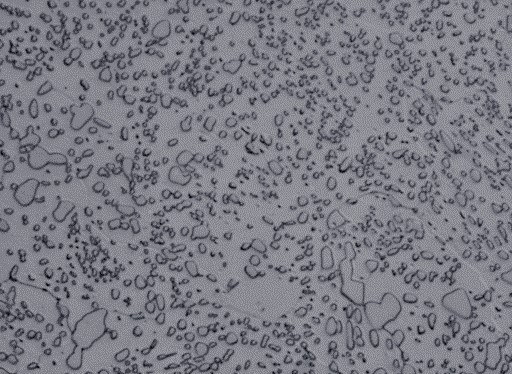
Author: Ali Kosari Mehr
Possible hardening effect of thermal treatment on martensitic steel:
To harden martensitic steel, one should deliberately select the strategy for thermal treatment and austenitization such that the enlargement of the grains, decarburization, and presence of the austenitic phase can be prevented [1]. In a reported case in which not only was a primary thermal treatment used, but also the samples were subjected to quench hardening and post-annealing, the hardness of martensitic steel reached the value of 700-800 HV (i.e., a threefold increase) [2].
Moreover, corrosion current hinges upon the amount of the chromium content and the extent to which carbides dissolve into the steel. Hence, to increase the corrosion resistance of steel, one should prevent the precipitation of chromium carbide and facilitate the dissolution of carbides and chromium in the texture. In this regard, conspicuous success in improving the corrosion resistance of martensitic steel has not been reported by these means, and all the efforts have been undertaken not to allow a further decrease in the corrosion resistance [3].
Possible hardening and anti-corrosive effect of thermal treatment and carburization at low temperatures on austenitic steel:
For improvement in mechanical properties and corrosion performance, it should be accommodated that the carbon is not easily dissolved in the steel at temperatures below 650°C and that chromium tends to form carbide. The precipitation of carbides leads to sensitization and a decrease in the amount of chromium in the vicinity of grain boundaries, culminating in the decreased fatigue and corrosion resistance [4]. To avoid the precipitation of carbides, one can use thermal treatment and carburization at low temperatures utilizing plasma; plasma keeps the chromium in a solid solution state and helps the carbon atoms to be incorporated into the surface of the austenitic steel to a depth of few microns [5]. According to the literature, by these means, the hardness and the corrosion resistance have ultimately improved by 500% (i.e., 1000-1200 HV) and 2000%, respectively [5, 6].
Possible hardening and anti-corrosive effect of plasma nitriding at low temperatures on steel:
by utilizing plasma nitriding, the formation of a solid solution state full of nitrogen – as a result nitrides – is expected, which could improve the mechanical properties and corrosion performance of steel. However, the precipitation of CrN – accordingly a decrease in the contribution of chromium in solid solution structure – is a factor decreasing the corrosion resistance of the steel [7, 8]. In this connection, it has been reported that the hardness and corrosion resistance can be increased by 600% (i.e., 1500 HV) and 200%, respectively [9–11].
In the following article, the hardening and anti-corrosive effects of heat treatment processes will be compared with those of thin-film processes.
References:
- Isfahany AN, Saghafian H, Borhani G (2011) The effect of heat treatment on mechanical properties and corrosion behavior of AISI420 martensitic stainless steel. J Alloys Compd 509:3931–3936. Webpage
- Barlow LD, Du Toit M (2012) Effect of austenitizing heat treatment on the microstructure and hardness of martensitic stainless steel AISI 420. J Mater Eng Perform 21:1327–1336. Webpage
- Scheuer CJ, Cardoso RP, Pereira R, et al (2012) Low temperature plasma carburizing of martensitic stainless steel. Mater Sci Eng A 539:369–372. Webpage
- Holcomb WF (1967) Carburization of type 304 stainless steel in liquid sodium. Nucl Eng Des 6:264–272. Webpage
- Sun Y (2013) Tribocorrosion behavior of low temperature plasma carburized stainless steel. Surf Coatings Technol 228:S342–S348. Webpage
- Martin FJ, Natishan PM, Lemieux EJ, et al (2009) Enhanced corrosion resistance of stainless steel carburized at low temperature. In: Metallurgical and Materials Transactions A: Physical Metallurgy and Materials Science. Springer, pp 1805–1810 Webpage
- Basu A, Majumdar JD, Alphonsa J, et al (2008) Corrosion resistance improvement of high carbon low alloy steel by plasma nitriding. Mater Lett 62:3117–3120. Webpage
- Gil L, Brühl S, Jiménez L, et al (2006) Corrosion performance of the plasma nitrided 316L stainless steel. Surf Coatings Technol 201:4424–4429. Webpage
- Liang W, Bin X, Zhiwei Y, Yaqin S (2000) The wear and corrosion properties of stainless steel nitrided by low-pressure plasma-arc source ion nitriding at low temperatures. Surf Coatings Technol 130:304–308. Webpage
- Liang W (2003) Surface modification of AISI 304 austenitic stainless steel by plasma nitriding. Appl Surf Sci 211:308–314. Webpage
- Singh GP, Alphonsa J, Barhai PK, et al (2006) Effect of surface roughness on the properties of the layer formed on AISI 304 stainless steel after plasma nitriding. Surf Coatings Technol 200:5807–5811. Webpage
-
 20 Aug, 2022What is Auger electron spectroscopy?
20 Aug, 2022What is Auger electron spectroscopy? -
 13 Jul, 2022Classification of vacuum pumps
13 Jul, 2022Classification of vacuum pumps
